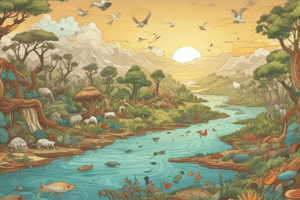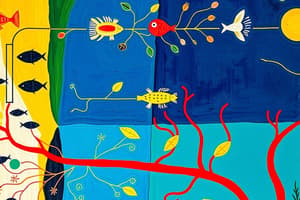Podcast
Questions and Answers
What is the name of the process that involves the movement of elements and compounds between living organisms, the Earth, and the atmosphere?
What is the name of the process that involves the movement of elements and compounds between living organisms, the Earth, and the atmosphere?
- Biogeochemical cycle (correct)
- Photosynthesis
- Ecological succession
- Water cycle
Which of the following is NOT a stage of the Water Cycle?
Which of the following is NOT a stage of the Water Cycle?
- Transpiration
- Precipitation
- Condensation
- Evaporation
- Decomposition (correct)
Which of the following is NOT a density-dependent factor?
Which of the following is NOT a density-dependent factor?
- Predation
- Habitat destruction (correct)
- Competition
- Disease
Which of the following is an example of a pioneer species?
Which of the following is an example of a pioneer species?
What is the process by which plants use sunlight to make food (glucose) and oxygen?
What is the process by which plants use sunlight to make food (glucose) and oxygen?
What is the main difference between primary and secondary succession?
What is the main difference between primary and secondary succession?
What is the term for the maximum number of individuals that an environment can support?
What is the term for the maximum number of individuals that an environment can support?
Which of the following is NOT a source of water pollution?
Which of the following is NOT a source of water pollution?
What type of pollution is caused by excessive nutrients in water, leading to algal blooms?
What type of pollution is caused by excessive nutrients in water, leading to algal blooms?
What type of relationship exists between a lion and a zebra?
What type of relationship exists between a lion and a zebra?
Which of these is NOT a type of relationship between organisms?
Which of these is NOT a type of relationship between organisms?
Flashcards
Food Chain
Food Chain
A simple, linear sequence showing the flow of energy and nutrients from one organism to another.
Food Web
Food Web
A complex network of interconnected food chains.
Predation
Predation
One organism (predator) kills and eats another (prey).
Competition
Competition
Signup and view all the flashcards
Mutualism
Mutualism
Signup and view all the flashcards
Commensalism
Commensalism
Signup and view all the flashcards
Parasitism
Parasitism
Signup and view all the flashcards
Biogeochemical Cycle
Biogeochemical Cycle
Signup and view all the flashcards
Water Cycle
Water Cycle
Signup and view all the flashcards
Evaporation
Evaporation
Signup and view all the flashcards
Condensation
Condensation
Signup and view all the flashcards
Precipitation
Precipitation
Signup and view all the flashcards
Infiltration
Infiltration
Signup and view all the flashcards
Runoff
Runoff
Signup and view all the flashcards
Transpiration
Transpiration
Signup and view all the flashcards
Carbon Cycle
Carbon Cycle
Signup and view all the flashcards
Photosynthesis
Photosynthesis
Signup and view all the flashcards
Respiration
Respiration
Signup and view all the flashcards
Decomposition
Decomposition
Signup and view all the flashcards
Nitrogen Cycle
Nitrogen Cycle
Signup and view all the flashcards
Nitrogen Fixation
Nitrogen Fixation
Signup and view all the flashcards
Nitrification
Nitrification
Signup and view all the flashcards
Assimilation
Assimilation
Signup and view all the flashcards
Ammonification
Ammonification
Signup and view all the flashcards
Denitrification
Denitrification
Signup and view all the flashcards
Ecological Succession
Ecological Succession
Signup and view all the flashcards
Primary Succession
Primary Succession
Signup and view all the flashcards
Secondary Succession
Secondary Succession
Signup and view all the flashcards
Study Notes
Food Webs and Relationships
- A food chain shows how energy and nutrients flow between organisms.
- A food chain starts with producers (plants) and proceeds to consumers.
- A food web is more complex than a food chain, showing interconnected food chains.
- Organisms in a food web can be part of multiple food chains.
- Predation is when one organism kills and eats another.
- Competition occurs when two organisms compete for the same resources.
- Mutualism occurs when both organisms benefit from the relationship.
- Commensalism occurs when one organism benefits, and the other is unaffected.
- Parasitism occurs when one organism benefits at the expense of another.
- A food chain is a simple, straight line showing energy flow.
- A food web is a complex network of interconnected food chains.
- Relationships describe how organisms interact (helping, harming, or having no effect).
Biogeochemical Cycles
- Biogeochemical cycles describe the movement of elements and compounds (biological, geological, and chemical).
- Cycles ensure essential elements (carbon, nitrogen, oxygen, and water) recycle in the environment.
- The water cycle describes the continuous movement of water.
- Evaporation: Water turns into vapor.
- Condensation: Water vapor cools and forms clouds.
- Precipitation: Water falls from the clouds as rain, snow, or hail.
- Infiltration: Water soaks into the ground.
- Transpiration: Plants release water vapor.
- Runoff: Water flows across the land.
- The carbon cycle describes how carbon moves between the atmosphere, organisms, and Earth's surface.
- Photosynthesis: Plants convert CO2 into glucose.
- Respiration: Organisms release CO2.
- Decomposition: Dead organisms break down, releasing carbon.
- Fossil fuels: Carbon stores in the Earth.
- The nitrogen cycle describes the movement of nitrogen through the atmosphere, soil, and organisms.
- Nitrogen fixation: Bacteria convert atmospheric nitrogen into ammonia.
- Nitrification: Bacteria convert ammonia into nitrites, then nitrates.
- Assimilation: Plants absorb nitrates.
- Ammonification: Decomposers release ammonia.
- Denitrification: Bacteria convert nitrates back to nitrogen gas.
- The phosphorus cycle describes the movement of phosphorus through the Earth's systems.
- Weathering: Phosphorus is released from rocks.
- Absorption: Plants absorb phosphorus.
- Decomposition: Decomposers return phosphorus to the soil.
- Sedimentation: Phosphorus settles into the ocean and forms new rocks.
Ecological Succession
- Ecological succession is the gradual replacement of one community of organisms by another over time.
- Two types of ecological succession:
- Primary succession: Occurs in areas with no soil (volcanic eruptions, glaciers).
- Pioneer species: First organisms to colonize
- Secondary succession: Occurs in areas where soil remains (fires, floods).
- Early growth: Grasses and small plants.
- Intermediate species: Shrubs and small trees.
- Climax community: Mature ecosystem.
Photosynthesis
- Photosynthesis is the process by which plants use sunlight to make food (glucose) from carbon dioxide and water.
- It uses chlorophyll (green pigment).
- The formula is 6CO2 + 6H2O + light energy → C6H12O6 + 6O2.
Population and Population Curves
- A population is a group of individuals of the same species in the same area at the same time.
- Population curves show how population size changes over time.
- There are different types of population growth curves:
- Exponential growth: Rapid growth when resources are unlimited.
- Logistic growth: Growth slows as the population approaches the carrying capacity (the maximum population size the environment can support).
- Constant growth: Overshoots and dieback, crashing after exceeding carrying capacity.
- Factors affecting population size:
- Biotic factors (birth rate, death rate, competition, predation).
- Abiotic factors (climate, food availability, space).
- Density-dependent factors (affect population based on size, disease, competition).
- Density-independent factors (affect populations regardless of size, natural disasters).
Water Pollution
- Water pollution is the contamination of water bodies by harmful substances.
- Types of water pollution:
- Chemical pollution (pesticides, fertilizers, heavy metals).
- Biological pollution (bacteria, viruses).
- Nutrient pollution (nitrogen, phosphorus).
- Physical pollution (sediment, plastics).
- Thermal pollution (high water temperatures).
- Effects: Harm to aquatic life, human health risks, ecosystem damage, and economic impacts.
Studying That Suits You
Use AI to generate personalized quizzes and flashcards to suit your learning preferences.




